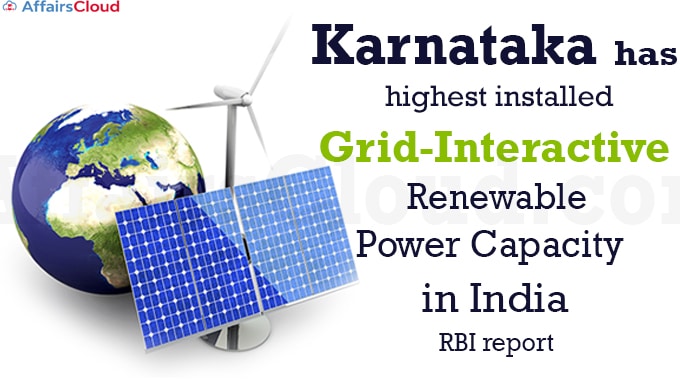 On November 19, 2022, the Reserve Bank of India (RBI) released the 7th edition of its statistical publication namely ‘Handbook of Statistics on Indian States 2021-22’. According to the publication, Karnataka has the highest installed grid-interactive renewable power capacity in India with a total installed capacity of 15,463 Megawatts (MW).
On November 19, 2022, the Reserve Bank of India (RBI) released the 7th edition of its statistical publication namely ‘Handbook of Statistics on Indian States 2021-22’. According to the publication, Karnataka has the highest installed grid-interactive renewable power capacity in India with a total installed capacity of 15,463 Megawatts (MW).
- It is followed by Tamil Nadu (TN), with 15,225 MW at 2nd; Gujarat, with 13,153 MW, at 3rd.
- It has been prepared under the supervision and overall guidance of Dr. Deba Prasad Rath, Principal Adviser, Department of Economic and Policy Research (DEPR), RBI.
Basis of Assessment:
Data for the calculation of state-wise total installed capacity of grid interactive renewable power had been sourced through Energy Statistics from the Ministry of Statistics and Programme Implementation (MoSPI).
- The states’ figures of total installed capacity of Grid Interactive Renewable Power are till 2021.
Key Points:
i.Gujarat was followed by Maharashtra (10,267 MW), Rajasthan (10,205 MW), Andhra Pradesh (8,969 MW), Madhya Pradesh (5,206 MW), Telangana (4,378 MW), Uttar Pradesh (3,879 MW), Punjab (1,617 MW) and Himachal Pradesh (988 MW) and Uttarakhand (713 MW)
ii.Renewable power includes power from various sources namely bio-power, solar power, small hydro power, waste to energy and wind power.
iii.According to Indian Energy Exchange (IEX), Karnataka distribution companies (discoms) had become the top seller of renewable energy under the Green Term Ahead Market (GTAM).
iv.This handbook provides wide-ranging data on socio-demographics, state domestic product, agriculture, price and wages, industry, infrastructure, banking and fiscal indicators across Indian states over various time periods ranging from 1951 to 2021-22.
v.It contains sections of Social and Demographic Indicators, Health, Agriculture, Environment, Infrastructure, and Fiscal.
- Health and environment are introduced in this 7th edition of handbook
Recent Related News:
i.Infibeam Avenues Limited (IAL), an e-commerce and payments solutions provider, which operates a flagship digital payment gateway CCAvenue app, has received in-principle approval from the Reserve Bank of India (RBI) to operate as a payment aggregator (PA).
ii.On October 11, 2022, the Reserve Bank of India (RBI) issued modified and consolidated guidelines viz. ‘RBI (Unhedged Foreign Currency Exposure-UFCE) Directions, 2022‘ w.e.f. January 1, 2023. These will be applicable to all commercial banks (excluding Payments Banks and Regional Rural Banks)
About Reserve Bank of India (RBI):
i.The Reserve Bank of India was established on April 1, 1935, in accordance with the provisions of the Reserve Bank of India Act, 1934.
ii.The Central Office of the Reserve Bank was initially established in Calcutta but was permanently moved to Mumbai in 1937.
iii.Though originally privately owned, since nationalization in 1949, the Reserve Bank is fully owned by the Government of India.




